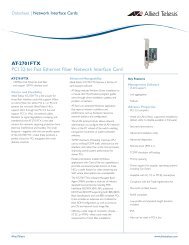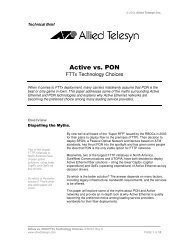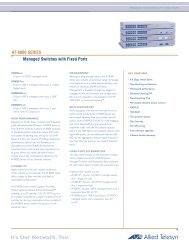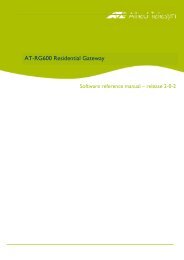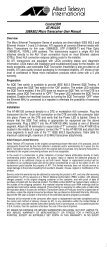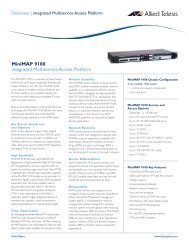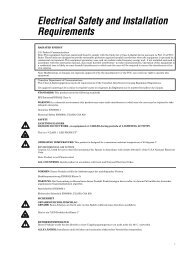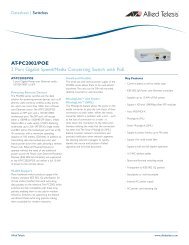How To Configure MRTG via SNMP using VLAN ... - Allied Telesis
How To Configure MRTG via SNMP using VLAN ... - Allied Telesis
How To Configure MRTG via SNMP using VLAN ... - Allied Telesis
You also want an ePaper? Increase the reach of your titles
YUMPU automatically turns print PDFs into web optimized ePapers that Google loves.
<strong>Allied</strong>Ware Plus OS<br />
<strong>How</strong> <strong>To</strong> |<br />
<strong>Configure</strong> the Switch and <strong>MRTG</strong> to Graph Traffic<br />
Rates for each <strong>VLAN</strong> <strong>via</strong> <strong>SNMP</strong> <strong>using</strong> <strong>VLAN</strong><br />
Statistics<br />
Introduction<br />
This document describes how to monitor the throughput for each <strong>VLAN</strong> on an x600 series<br />
switch. <strong>To</strong> do this, you utilise the <strong>VLAN</strong> statistics, and then configure Multi Router Traffic<br />
Grapher (<strong>MRTG</strong>) to query the <strong>VLAN</strong> statistics Management Information Base (MIB) <strong>via</strong><br />
Simple Network Management Protocol (<strong>SNMP</strong>). <strong>MRTG</strong> can then use the results it obtains to<br />
create graphical representations of the traffic throughput over different periods of time.<br />
This solution has several advantages over the previous <strong>Allied</strong>Ware solution <strong>using</strong> QoS traffic<br />
classes. It is easier to configure the switch and to graph upload and download traffic, and you<br />
do not need to place the switch into QoS enhanced mode, which can introduce table size<br />
limitations.<br />
Note:<br />
<strong>VLAN</strong> statistics are only supported on the x600 series switches; therefore you<br />
cannot use this method to graph traffic rates for <strong>VLAN</strong>s on any other switches. For<br />
more information on <strong>VLAN</strong> statistics, see the “<strong>VLAN</strong> Statistics” section of the<br />
“<strong>VLAN</strong> Commands” chapter of the Software Reference.<br />
This document assumes that you are already familiar with <strong>MRTG</strong>. For more information and<br />
to download it, see oss.oetiker.ch/mrtg/.<br />
What information will you find in this document?<br />
This <strong>How</strong> <strong>To</strong> Note includes the following information:<br />
• "Switch Configuration" on page 3<br />
• "<strong>MRTG</strong> configuration" on page 6<br />
• "Examples of the graphical results" on page 10<br />
<strong>Allied</strong>Ware Plus TM<br />
OPERATING SYSTEM<br />
C613-16163-00 REV A<br />
www.alliedtelesis.com
Introduction<br />
Which products and software version does it apply to?<br />
This <strong>How</strong> <strong>To</strong> Note applies to the following <strong>Allied</strong> <strong>Telesis</strong> switches running the <strong>Allied</strong>Ware<br />
Plus OS:<br />
• x600 series switches<br />
<strong>VLAN</strong> statistics are supported on x600 series switches running software version 5.3.3 or<br />
later.<br />
Related <strong>How</strong> <strong>To</strong> Notes<br />
You also may find the following <strong>How</strong> <strong>To</strong> Notes useful:<br />
• <strong>How</strong> <strong>To</strong> <strong>Configure</strong> the Switch and <strong>MRTG</strong> to Graph Traffic Rates for each <strong>VLAN</strong> <strong>via</strong> <strong>SNMP</strong><br />
<strong>How</strong> <strong>To</strong> Notes are available from www.alliedtelesis.com/resources/literature/howto.aspx.<br />
Page 2 | <strong>Allied</strong>Ware OS <strong>How</strong> <strong>To</strong> Note: QoS counters with <strong>MRTG</strong>
Example<br />
Example<br />
port1.0.1<br />
vlan2<br />
port1.0.2-1.0.4<br />
vlan3<br />
port1.0.24<br />
tagged vlan2-3<br />
uplink port<br />
Customer 1<br />
port1.0.23<br />
vlan1<br />
management<br />
port<br />
x600-24Ts<br />
Customer 2<br />
Switch Configuration<br />
1. Create the customer <strong>VLAN</strong><br />
Use the commands:<br />
awplus(config)#vlan database<br />
awplus(config-vlan)#vlan 2-3<br />
2. Add the customer ports to the customer <strong>VLAN</strong>s<br />
Use the commands:<br />
awplus(config)#int port1.0.1<br />
awplus(config-if)#description customer 1 port 1<br />
awplus(config-if)#switchport access vlan 2<br />
awplus(config-if)#int port1.0.2<br />
awplus(config-if)#description customer 2 port 1<br />
awplus(config-if)#switchport access vlan 3<br />
awplus(config-if)#int port1.0.3<br />
awplus(config-if)#description customer 2 port 2<br />
awplus(config-if)#switchport access vlan 3<br />
awplus(config-if)#int port1.0.4<br />
awplus(config-if)#description customer 2 port 3<br />
awplus(config-if)#switchport access vlan 3<br />
Page 3 | <strong>Allied</strong>Ware OS <strong>How</strong> <strong>To</strong> Note: QoS counters with <strong>MRTG</strong>
Switch Configuration<br />
3. Add the uplink port as a tagged member of the customer <strong>VLAN</strong>s<br />
Use the commands:<br />
awplus(config)#int port1.0.24<br />
awplus(config-if)#description uplink port<br />
awplus(config-if)#switchport mode trunk<br />
awplus(config-if)#switchport trunk allowed vlan add 2-3<br />
4. Create the <strong>VLAN</strong> statistics instances on the customer ports for upload<br />
traffic<br />
Use the commands:<br />
awplus(config)#int port1.0.1<br />
awplus(config-if)#vlan 2 statistics name c1u<br />
awplus(config)#int port1.0.2-1.0.4<br />
awplus(config-if)#vlan 3 statistics name c2u<br />
Note:<br />
Although it is possible to create longer, more meaningful names for <strong>VLAN</strong> statistics<br />
instances, for this example short names have been specified to keep the <strong>MRTG</strong><br />
configuration as simple as possible. For example, “c1u” instead of “customer 1<br />
upload”.<br />
The <strong>SNMP</strong> Object Identifier (OID) to use in <strong>MRTG</strong> for each <strong>VLAN</strong> statistics instance is<br />
comprised of, in this order:<br />
• the base OID for “atVlanStatCollectionIngressOctects”<br />
• a decimal number denoting the number of characters in the name of the <strong>VLAN</strong> statistics<br />
instance<br />
• the ASCII value for each character in the name of the <strong>VLAN</strong> statistics instance.<br />
Example: For the <strong>VLAN</strong> statistics name “c1u”, the OID will be:<br />
atVlanStatCollectionIngressOctects.3.99.49.100<br />
3 = Number of characters in the <strong>VLAN</strong> statistics name<br />
99 = ASCII value of “c”<br />
49 = ASCII value of “1”<br />
100 = ASCII value of “u”<br />
Page 4 | <strong>Allied</strong>Ware OS <strong>How</strong> <strong>To</strong> Note: QoS counters with <strong>MRTG</strong>
Switch Configuration<br />
5. Create the <strong>VLAN</strong> statistics instances on the uplink port for download traffic<br />
Use the commands:<br />
awplus(config)#int port1.0.24<br />
awplus(config-if)#vlan 2 statistics name c1d<br />
awplus(config-if)#vlan 3 statistics name c2d<br />
6. <strong>Configure</strong> <strong>SNMP</strong><br />
Use the command:<br />
awplus(config)#snmp-server community test rw<br />
7. <strong>Configure</strong> the management IP address<br />
Use the commands:<br />
awplus(config)#int vlan1<br />
awplus(config-if)#ip address 10.1.1.1/24<br />
Page 5 | <strong>Allied</strong>Ware OS <strong>How</strong> <strong>To</strong> Note: QoS counters with <strong>MRTG</strong>
<strong>MRTG</strong> configuration<br />
<strong>MRTG</strong> configuration<br />
Using cfgmaker as a starting point<br />
The simplest way to create the <strong>MRTG</strong> configuration is to use <strong>MRTG</strong>’s “cfgmaker” to create<br />
the base template configuration and then edit the configuration file manually to use the<br />
<strong>SNMP</strong> OID. It is not possible to use cfgmaker to automatically create the complete config file.<br />
<strong>MRTG</strong>’s cfgmaker creates a config script by contacting the router <strong>via</strong> <strong>SNMP</strong> and reading<br />
particular MIB objects, such as system description, or the number of interfaces. The cfgmaker<br />
PC must be able to contact the router <strong>via</strong> its IP address, <strong>SNMP</strong> must be correctly configured<br />
on the router, and you must specify the correct community name in the cfgmaker command<br />
on the PC.<br />
We used the following cfgmaker command:<br />
perl cfgmaker test@10.1.1.1 --ifref=descr --global "WorkDir: C:www\mrtg" -<br />
-output mrtg.cfg<br />
The resulting config file contains an entry for each interface. Each entry starts with several<br />
commented-out lines like the following:<br />
### Interface 50 >> Descr: 'port50' | Name: 'port50' | Ip: '' | Eth: '' ###<br />
### The following interface is commented out because:<br />
### * it is operationally DOWN<br />
### * has a speed of 0 which makes no sense<br />
There will be an entry created in the configuration template file for every interface on the<br />
device, whether it is up or down. Interfaces which are physically or administratively down will<br />
display with all attributes commented out.<br />
Modifying the configuration template<br />
After <strong>using</strong> cfgmaker to get a configuration template, you modified the template to use the<br />
<strong>SNMP</strong> OIDs of the <strong>VLAN</strong> statistics instances, rather than the physical interfaces created by<br />
cfgmaker. Because the number of entries you need depends on the number of <strong>VLAN</strong><br />
statistics instances you want to graph, you can delete any automatically generated entries that<br />
aren’t required, and if more entries are required you can add these manually, provided they<br />
follow the same format.<br />
This section contains our modified configuration template, showing which variables you<br />
should set in order for <strong>MRTG</strong> to obtain the <strong>VLAN</strong> statistics information <strong>via</strong> <strong>SNMP</strong>. Any line<br />
preceded by “#” is a comment, and is ignored by <strong>MRTG</strong>.<br />
More information about the syntax is given after the excerpt, in particular about the syntax<br />
for the Target and MaxBytes parameters.<br />
Page 6 | <strong>Allied</strong>Ware OS <strong>How</strong> <strong>To</strong> Note: QoS counters with <strong>MRTG</strong>
<strong>MRTG</strong> configuration<br />
### Interface 5001 >> Descr: 'Customer1' | Name: 'vlan2' | Ip: '' | Eth: '' ###<br />
Target[10.1.1.1_5001]:<br />
1.3.6.1.4.1.207.8.4.4.3.16.1.2.1.5.3.99.49.117&1.3.6.1.4.1.207.8.4.4.3.16.1.2.1.5.3.99.49<br />
.100:test@10.1.1.1:::::2<br />
SetEnv[10.1.1.1_5001]: <strong>MRTG</strong>_INT_IP="" <strong>MRTG</strong>_INT_DESCR="port1.0.1"<br />
MaxBytes[10.1.1.1_5001]: 1250000<br />
Title[10.1.1.1_5001]: Traffic Analysis for Customer 1 -- awplus<br />
Page<strong>To</strong>p[10.1.1.1_5001]: Traffic Analysis for Customer 1 -- awplus<br />
<br />
<br />
<br />
System:<br />
awplus in <br />
<br />
<br />
Maintainer:<br />
<br />
<br />
<br />
Description:<br />
port1.0.1 <br />
<br />
<br />
ifType:<br />
vlan<br />
<br />
<br />
ifName:<br />
vlan 2<br />
<br />
<br />
Max Speed:<br />
12.5 MBytes/s<br />
<br />
<br />
<br />
### Interface 5002 >> Descr: 'Customer2' | Name: 'vlan3' | Ip: '' | Eth: '' ###<br />
Target[10.1.1.1_5002]:<br />
1.3.6.1.4.1.207.8.4.4.3.16.1.2.1.5.3.99.50.117&1.3.6.1.4.1.207.8.4.4.3.16.1.2.1.5.3.99.50<br />
.100:test@10.1.1.1:::::2<br />
SetEnv[10.1.1.1_5002]: <strong>MRTG</strong>_INT_IP="" <strong>MRTG</strong>_INT_DESCR="port1.0.1"<br />
MaxBytes[10.1.1.1_5002]: 3750000<br />
Title[10.1.1.1_5002]: Traffic Analysis for Customer 2 -- awplus<br />
Page<strong>To</strong>p[10.1.1.1_5002]: Traffic Analysis for Customer 2 -- awplus<br />
<br />
<br />
<br />
System:<br />
awplus in <br />
<br />
<br />
Maintainer:<br />
<br />
<br />
<br />
Description:<br />
customer 2<br />
<br />
<br />
ifType:<br />
vlan<br />
<br />
<br />
ifName:<br />
vlan 3<br />
<br />
<br />
Max Speed:<br />
37.5 MBytes/s<br />
<br />
<br />
<br />
WorkDir: c:\www\mrtg<br />
Page 7 | <strong>Allied</strong>Ware OS <strong>How</strong> <strong>To</strong> Note: QoS counters with <strong>MRTG</strong>
Explanation of parameters<br />
<strong>MRTG</strong> configuration<br />
There are five parameters in the previous excerpt: Target, SetEnv, MaxBytes, Title, and<br />
Page<strong>To</strong>p.<br />
In this file entry, the Title and Page<strong>To</strong>p parameters set the graphical display descriptions and<br />
layout. The SetEnv parameter lets you pass data to a threshold script. We left the SetEnv<br />
parameter unchanged from the default.<br />
The Target and MaxBytes parameters are most important. The syntax for these is complex, and<br />
is described below.<br />
Caution: The values of these parameters must use the format shown, or the configuration file<br />
will not work correctly.<br />
MaxBytes<br />
parameter<br />
The syntax is:<br />
MaxBytes[switchIPAddress_configurationFileEntry]: MaxPortSpeedInBytes<br />
The parameters inside the brackets are automatically generated by cfgmaker, and you do not<br />
have to modify them.<br />
The MaxBytes parameter determines the maximum value for the <strong>MRTG</strong> graph to display.<br />
Therefore, if the customer <strong>VLAN</strong> has more than one port, it is important that you adjust this<br />
value so the graph takes the total bandwidth into account.<br />
Set the MaxPortSpeedInBytes parameter value to: (the number of ports in the customer<br />
<strong>VLAN</strong>) x (the maximum speed in bytes of a single port).<br />
Target<br />
parameter<br />
The syntax is:<br />
Target[switchIPAddress_configurationFileEntry]:<strong>SNMP</strong>_OID_in&<strong>SNMP</strong>_OID_out:<br />
<strong>SNMP</strong>Community@switchIPAddress:::::<strong>SNMP</strong>version<br />
The parameters inside the brackets are automatically generated by cfgmaker, and you do not<br />
have to modify them.<br />
The <strong>SNMP</strong>_OID_in and <strong>SNMP</strong>_OID_out parameters specify the <strong>SNMP</strong> OIDs that <strong>MRTG</strong> will<br />
query to obtain the “in” traffic (traffic “downloaded”) and the “out” traffic (traffic “uploaded”)<br />
respectively.<br />
The <strong>SNMP</strong> Object Identifier (OID) to use in <strong>MRTG</strong> for each <strong>VLAN</strong> statistics instance is<br />
comprised of, in this order:<br />
• the base OID for “atVlanStatCollectionIngressOctects”<br />
• a decimal number denoting the number of characters in the name of the <strong>VLAN</strong> statistics<br />
instance<br />
• the ASCII value for each character in the name of the <strong>VLAN</strong> statistics instance.<br />
Page 8 | <strong>Allied</strong>Ware OS <strong>How</strong> <strong>To</strong> Note: QoS counters with <strong>MRTG</strong>
<strong>MRTG</strong> configuration<br />
Example: For the <strong>VLAN</strong> statistics name “c1u”, the OID will be:<br />
atVlanStatCollectionIngressOctects.3.99.49.100<br />
3 = Number of characters in the <strong>VLAN</strong> statistics name<br />
99 = ASCII value of “c”<br />
49 = ASCII value of “1”<br />
100 = ASCII value of “u”<br />
You can either manually work out the ASCII representation of the <strong>VLAN</strong> statistics name, or it<br />
can be easier to use an <strong>SNMP</strong> MIB browser to do a <strong>SNMP</strong>WALK of the<br />
“atVlanStatCollectionIngressOctects” OID once the <strong>VLAN</strong> statistics names are configured on<br />
the switch.<br />
The OID for “atVlanStatCollectionIngressOctects” is as follows:<br />
1.3.6.1.4.1.207.8.4.4.3.16.1.2.1.5<br />
The <strong>SNMP</strong>Community and switchIPAddress parameters are self explanatory, although it is very<br />
important to use the correct syntax as shown above.<br />
The <strong>SNMP</strong>version parameter must be preceded by five colons, and must always be set to 2.<br />
Page 9 | <strong>Allied</strong>Ware OS <strong>How</strong> <strong>To</strong> Note: QoS counters with <strong>MRTG</strong>
Examples of the graphical results<br />
Examples of the graphical results<br />
Below are samples of the graphical output created by <strong>MRTG</strong> for the above configuration<br />
example. <strong>MRTG</strong> actually produces output as HMTL pages with embedded PNG image files,<br />
but the HTML pages look very similar to what is shown below.<br />
Customer 1<br />
Page 10 | <strong>Allied</strong>Ware OS <strong>How</strong> <strong>To</strong> Note: QoS counters with <strong>MRTG</strong>
Customer 2<br />
USA Headquarters | 19800 North Creek Parkway | Suite 100 | Bothell | WA 98011 | USA | T: +1 800 424 4284 | F: +1 425 481 3895<br />
European Headquarters | Via Motta 24 | 6830 Chiasso | Switzerland | T: +41 91 69769.00 | F: +41 91 69769.11<br />
Asia-Pacific Headquarters | 11 Tai Seng Link | Singapore | 534182 | T: +65 6383 3832 | F: +65 6383 3830<br />
www.alliedtelesis.com<br />
© 2010 <strong>Allied</strong> <strong>Telesis</strong>, Inc. All rights reserved. Information in this document is subject to change without notice. <strong>Allied</strong> <strong>Telesis</strong> is a trademark or registered trademark of <strong>Allied</strong> <strong>Telesis</strong>, Inc. in the United States and other countries.<br />
All company names, logos, and product designs that are trademarks or registered trademarks are the property of their respective owners.<br />
C613-16121-00 REV A


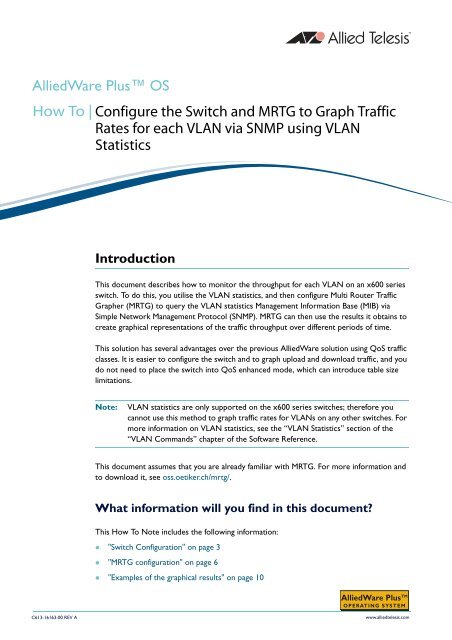
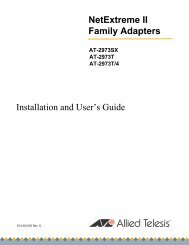

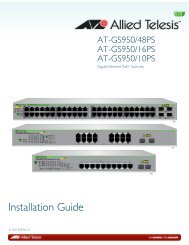
![AT-8100L/8POE-E [Rev B] - Allied Telesis](https://img.yumpu.com/25714603/1/190x245/at-8100l-8poe-e-rev-b-allied-telesis.jpg?quality=85)
